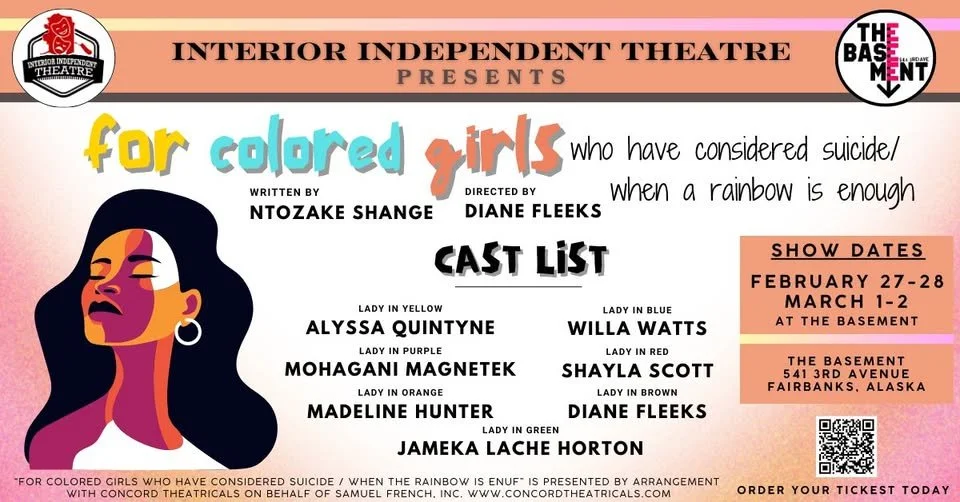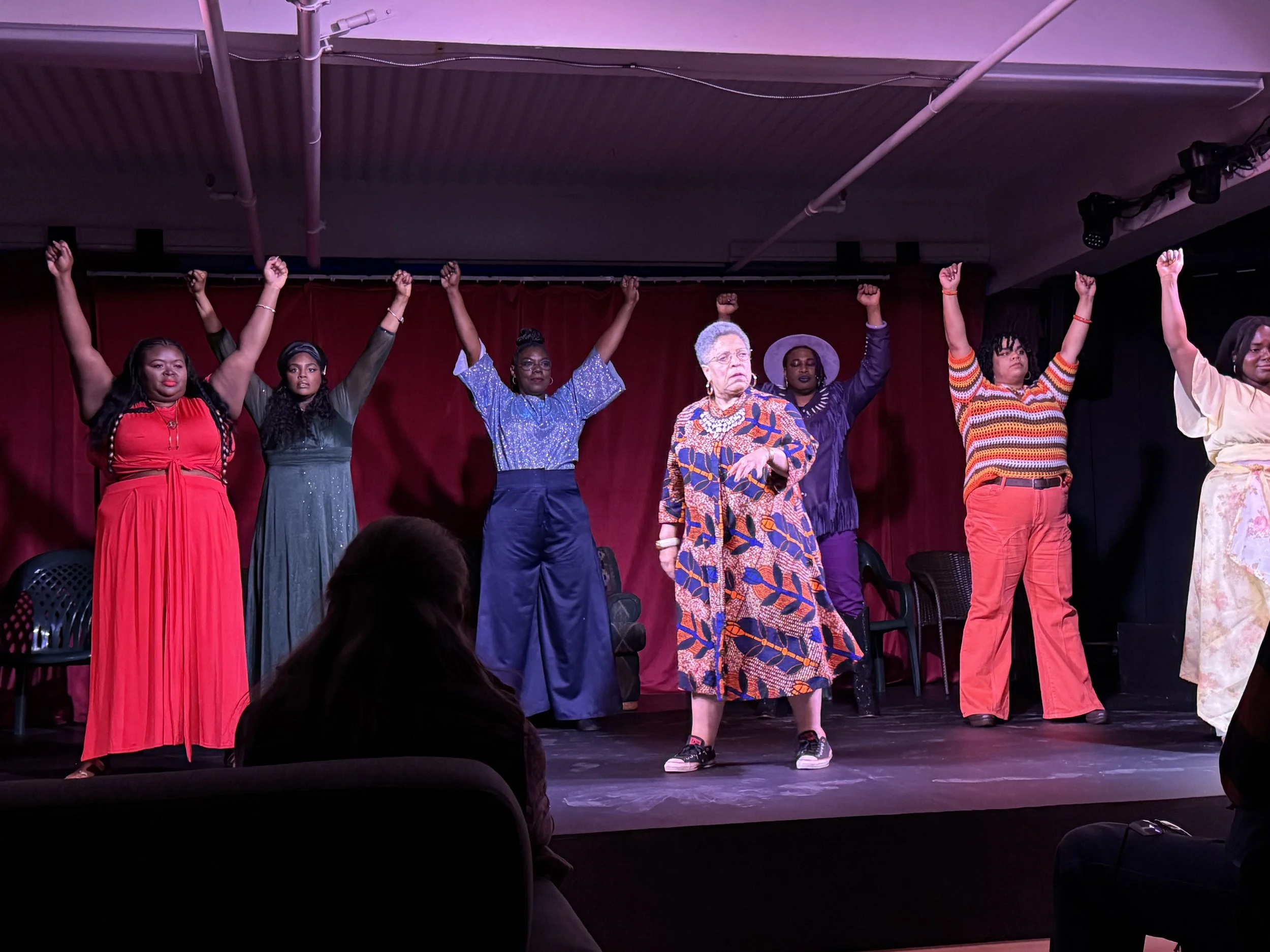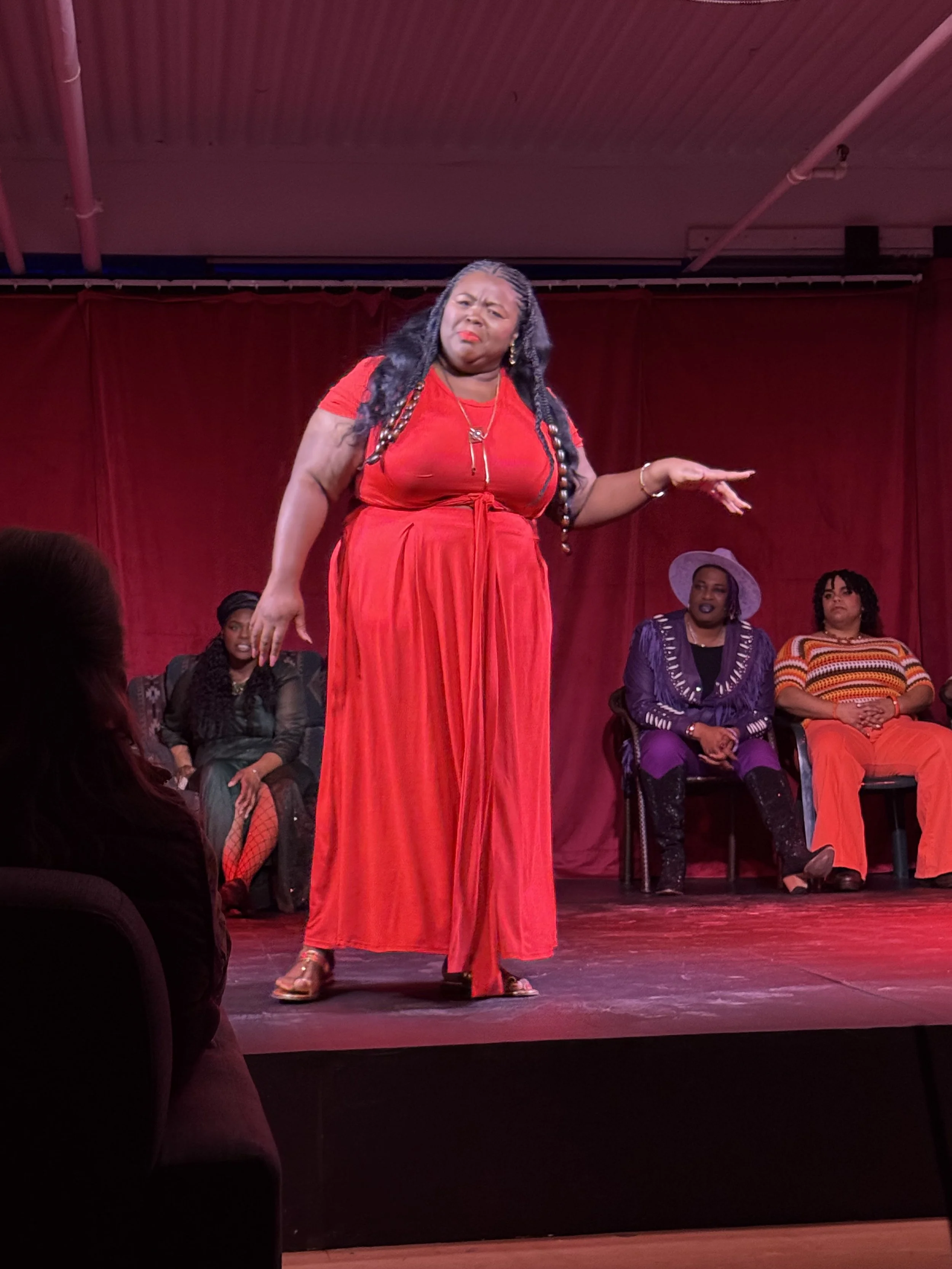For Colored Girls Who Have Considered Suicide / When a Rainbow Is Enuf - Review
By Royce Walston
An Experience Only a Rainbow Can Explain
From February 27 to March 2, the Interior Independent Theatre, hosted by The Basement, put on the renowned play For Colored Girls Who Have Considered Suicide / When a Rainbow Is Enuf. The play is a Black theatre piece written by Ntozake Shange, an African American playwright and poet, in 1975. Consisting of twenty to twenty-two poems, For Colored Girls… consists of poetic monologues, choreography with music, and symbolic moments. This is known as a choreopoem. This play became a book by Shange and then a movie re-written, produced, and directed by Tyler Perry in 2010.
“Come Share Our World”
Photo by Royce Walston
Katelyn Nelson, the assistant director of this rendition, set the stage for these powerful women to take the stage not just to tell the audience a story but to make them a part of something that, regardless of race, gender, or experiences, they won't forget. Once you enter The Basement, you are met with soothing lights that don’t hurt your eyes, music from popular black artists, couches that take you in as if you’ve already been there, and a box stage with a small couch and chairs lined along the back wall.
The feelings present in that room are personal before the show even begins, breaking this professional ideology that comes with the origins of theatre. This wasn’t your stereotypical play when the lights come down and the audience takes their seats. It was you sitting at home laughing or crying over a movie with your family. It was you singing along in the car with your friends with the windows down. It was being in church and calling out to the lord during a spiritual sermon. It was cheering on your friends when they needed you most. It was an experience many didn’t get to have.
It was Black theatre.
Photo by Royce Walston
This is when the actors enthuse the audience to interact with the actors verbally, for example, by calling out to them when something connects with them, like a call and response. For Colored Girls… is the perfect play because of its vulgarness and bluntness and its relatability to your sex, gender, race, sexuality, and experiences. In Black theatre, there is no sugarcoating it. This is real life, even if it’s shown through a character on a stage. It also probes the question of what being black is really like. What defines that life and makes it so different from others?
Directed by and starring the community theatre-driven Diane Fleeks, who, in this rendition, played 'Lady in Brown.” Apple Mohagani Mangetek, the spiritual anthropology PhD student, played “Lady in Purple.” Jameka Lache Horton, honored to make the world smile, and the social coordinator, played “Lady in Green.” Madeline Hunter, who showed their love for dance and choreography on stage, played “Lady in Orange.” Alyssa Quintyne painted a beautiful picture for the audience with the costumes and played “Lady in Yellow.” Shayla Scott, a woman with a strong voice for acting and choir, played “Lady in Red.” Finally, Willa Watts, a woman of many talents with a doctorate in Sacred Music, played “Lady in Blue.” Those were our ladies of the night.
“I loved you on purpose”
Their performance as actors and storytellers made us, the audience, a part of the very words they spoke of, changing the experience from enjoying what you're watching and enjoying what you can be a part of. As said by Diane Fleeks after the performance: “This 7-week process of this production was a labor of love that the audience helped with their call and response.”
Throughout the play, the ladies show us what black joy looks like, from playing kids' games to dancing and singing. They also chime in when others are monologuing by calling out to them as if they were in church with their fans during a sermon. This is pertinent because the ladies and the audience do it together. By telling these ladies' stories of love, life, spirituality, and dreams, one's relationship becomes more profound. This is why, as the play continues, we see a bond of womanhood that is masked by their exterior blackness that the stereotypes of how black women are not only treated but perceived are found. That bond is pure and supported by what the very name explains: its sisterhood. This sisterhood is the only thing women are born into in this world, knowing the unwritten rules, too. The only difference between sisters is the braids in their hair and the hand they hold to get through it. This play shows how an ever-changing world of humor, tragedy, familiarity, and trust is, not only through the colors they wear, the words they speak, the songs they sing, but how they envelop the audience in the story we all don’t know the ending to.
“The nature of rape has changed”
For Colored Girls… addresses a multitude of issues from multiple points of view. This darker theme began to reveal the nature of Ntozake's true intentions as the poems no longer had the kind remarks and smiles of those on stage but the lights shifting as they are struck or the vulgarness of the truth being told from the scars they're left with from the challenges they face. The play takes a sharp turn as they continue to discuss what it is like being not a victim but a survivor of rape, assault, abortion, racism, sexism, infidelity, and abandonment. Through distinct positions onstage, lighting, and vocal pitches, we, the audience, lose ourselves in what is truly a transformative experience of pain and the familiarity of struggling. It no longer felt like a play for the actors or the audience. It was empathy for those who suffered just as we have. An experience that isn’t seen in modern theatre anymore. That is because Black theatre is ever personal and causes a rainbow of emotions.
“Poem is my thank You to Music, and I loved You More than a poem”
That play was for those lost in a world where people think your difference makes you a lost cause. That play was for those women who needed a hand to hold to make it better. This play is for colored girls, but everyone knew they had walked away with something when those rainbow-gowned women took their bows on Friday, February 28th, and the lights went up.
This rendition of For Colored Girls Who Have Considered Suicide / When a Rainbow Is Enuf was a revolutionary performance that honored Ntozake Shange and was the perfect ending to Black History Month, leaving a beautiful mark here in Fairbanks, Alaska. It was an honor to be there, and to the performers, thank you and brava.
Photo by Royce Walston
“The rainbow is a fabulous symbol for me. If you see only one color, it’s not beautiful. If you see them all, it is. A colored girl, by my definition, is a girl of many colors, but she can only see her overall beauty if she can see all the colors of herself: To do that, she has to look deep inside her. And when she looks inside herself, she will find…Love and beauty.”
- Ntozake Shange





